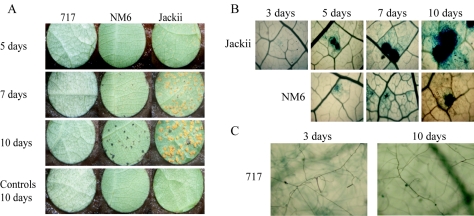FIG. 2.
M. medusae growth on three different poplar hosts. (A) Three poplar clones had different responses to M. medusae inoculation. Susceptible clone Jackii had numerous uredinial pustules 10 days after inoculation. Resistant clone NM6 had necrotic lesions characteristic of the hypersensitive response due to a gene for gene interaction. No symptoms were found on nonhost clone 717. (B) M. medusae grew on both clone Jackii and clone NM6. Microscopic observations showed that the uredinial pustule size increased dramatically from 3 to 10 days after inoculation on clone Jackii. The pustule size also increased on clone NM6 but did not reach the size seen on clone Jackii. The brown color on NM6 after 10 days was due to visualization of the uredinial pustule in a necrotic lesion. Magnification, ×100. (C) M. medusae germinated on clone 717. Germination was observed on clone 717 3 days after inoculation, but no further progress was observed after 10 days. Magnification, ×400.

